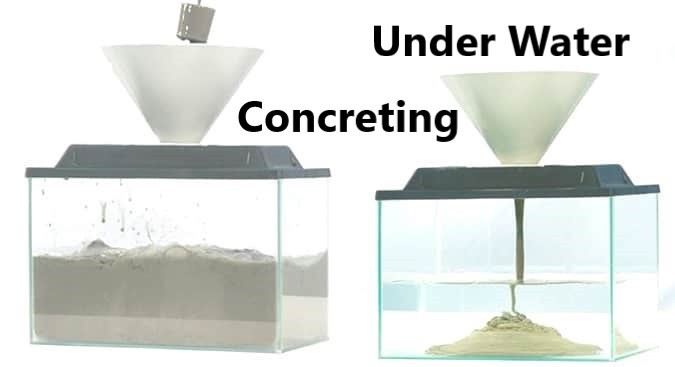
As the name suggests, underwater concrete is installed below the water line and can be used for:
- Port and harbour installations
- Bridge piers in rivers
- Water industry structures
- Metro systems
- Deep shafts in unstable ground
Composition (Example 0 – 32 mm):
- Aggregate
– Use an aggregate suitable for pumped mixes
– Fines including cement > 400 kg/m3 - Cement and Powder Additives
– Minimum cement content 350 kg/m3
– Limestone can be added to the fines content in the mix design - Admixtures
– Superplasticiser for the reduction of free water in the mix
– Mix stabiliser to minimise washout effect of fines and cement (especially in running water conditions)
Special requirements
Standard method is pumping a suitably modified mix through a standard concrete pump. The end of the delivery pipe must be kept deep enough in the fresh concrete. Another method of placing underwater concrete with minimum loss is the tremie process (Contractor Method). The concrete is placed directly through a 20 – 40 cm diameter pipe into and through the concrete already installed. The pipe is raised continuously, but the bottom end must always remain sufficiently submerged in the concrete to prevent the water going back into the pipe.
Other important considerations:
- As the flow rate of water increases, more leaching can occur, it is possible to design the concrete to minimize washout at various water flow rates
- Avoid pressure differences on the pipe (such as water level differences in shafts)
Sika Product Use
- Sika® ViscoCrete® – Superplasticizer
– Improves the consistence
– Reduces the water content - Sika® Stabilizer – Stabilizer
– Improves the cohesion
– Prevents the fines from leaching
– For use in still and especially flowing conditions - Sika® UCS Pak – Underwater Stabilizer
– Improves the cohesion
– Prevents the fines from leaching
– For use in still and especially flowing conditions (tidal situations)
CASE STUDY – I
Folly Pier, Anstruther, Scotland

Project Description
This listed pier in Anstruther harbour was once the centre of the Scottish fishing industry. Picturesque Anstruther harbour is now a popular tourist attraction and is mainly occupied by private pleasure crafts.
The Folly Pier in the centre of the harbour provides primary access to the floating pontoons and is also used for parking and as a working area for harbour users.
Project Requirements
A structural survey by Fife Council in 1995 identified problems with the aging skeletal under-structure of the pier. After further monitoring, a point was reached where repairs had to be undertaken in order to retain the future integrity of the pier. As the pier is a listed structure, it was essential that any repair works did not affect the external appearance of the pier. It was also important that the repair work be long lasting and completed to a set budget and within a short time window to minimize any disruption to users of the pier.
Sika Solution
After a cost/benefit analysis was completed, it was decided to in-fill the void beneath the pier with mass concrete, rather than undertake repairs to the existing support framework. As the majority of the concrete was to be placed underwater, a specially formulated mix was required that would give very high resistance to washout and also be capable of being placed without compaction.
The tried and tested Sika Underwater Concrete System was the solution of choice, and Breedon Concrete supplied 2,000 cubic metres of a special mix design formulated for this project.
The Sika Underwater Concrete System uses Sika UCS powdered underwater stabilizer to produce a very cohesive, non-segregating mix with excellent wash-out resistance, even in flowing conditions. This is combined with a powerful superplastisiser, Sika Viscocrete®-10, to produce a free flowing concrete mix that can be placed underwater without compaction.
The concrete was placed within black stainless steel sheeting by three divers from underwater engineers Atlas Marine.
CASE STUDY – II
West Coast Rail Viaduct
Carlisle, Cumbria

Project Description
Spanning the River Eden between the Sheepmount area of Carlisle and Etterby, the 70 metre long rail viaduct comprises five stone piers and a concrete deck.
Project Requirements
Underwater surveys for client Network Rail Infrastructure Projects (Civils) confirmed that the viaduct substructure was being scoured requiring a long term solution which offered scour protection to the masonry and foundations.
Sika Solution
Sika concrete admixtures played their part in the various specialist concrete mixes that were supplied by Hanson Concrete for the bridge strengthening works. To repair the stone piers, Story Contracting installed a total of 64 tonnes of permanent interlocking sheet piles around the piers. The piles were driven to refusal, toeing into the mudstone bedrock. Following this, 282m3 of Hanson concrete containing Sika® UCS Pak, a specialist underwater admixture, was poured between the pier and the sheet piles, with a capping beam formed at cut-off level.
Used for the production of underwater concrete and meeting the requirements of BS 8443, Sika® UCS Pak prevents the wash out of the cement paste and increases the cohesion of the concrete. Sika® UCS Pak is packaged in water soluble bags to enable ease of addition on site.
Another challenge for the project was installing a temporary causeway in order to gain sufficient access across the river, and to undertake the works. Stone filled gabion baskets were stacked upon the river bed, and 6m steel bridge plates used to span the gap. A stone piling platform was then installed between the piers, with large diameter pipes passing through the construction to maintain river flow.
The works were completed and implemented in controlled stages with the final design maintaining the river flow as well as meeting the strict environmental conditions surrounding fish migration. The newly renovated and strengthened viaduct was put to the test in December 2015 when the River Eden encountered substantial flooding. Inspections to the structure in January 2016 showed no adverse effects on any of the bridge strengthening works.
With the viaduct foundation repairs now complete, the use of Sika Admixtures in the underwater concrete foundations has ensured the success of this important infrastructure project and the long term future of this important section of the West Coast Mainline.
Technical services manager, Terry Balmer adds that Hanson’s expertise in “bespoke” concrete mix design is also being utilised to repair many of the damaged structures across Cumbria following the devastation storm Desmond brought to the area. The majority of contracts require a different approach and our products are at the forefront of delivering value added engineering to our customers.
ADVANTAGES OF UNDERWATER CONCRETE:
- It allows construction and excavation in a poor environment.
- It provides a harmless environment for working.
- Sheet piles are easy to install and remove.
- The material can usually be reused on other projects.
DISADVANTAGES OF UNDERWATER CONCRETE:
- Rapidly rising water can eject the scour hole & it is one of the main fundamental causes of bridge failure.
- Cracks, scaling, crazing and potting are very common in concrete.
- Rebar is steel reinforcement bars that are passively located within the concrete, they undergo corrosion.
- The concrete broke, flattened or piled up due to poor installation and environmental factors.







